Creating a native garden layout focuses on water efficiency while enhancing beauty. One effective approach is designing a rain garden that captures stormwater, filters pollutants, and utilizes native plants. Xeriscape rock gardens feature drought-resistant plants and gravel for low water use. Pollinator-friendly layouts attract beneficial insects, while Mediterranean planting schemes thrive in dry conditions. Drought-tolerant perennial beds showcase vibrant blooms with minimal care. If you're looking for more innovative gardening ideas, you'll find plenty as you explore further.
Quick Takeaways
- Incorporate rain gardens to capture stormwater, filter pollutants, and enhance overall water quality while using native plant species.
- Design dry stream beds to manage drainage effectively, preventing erosion and creating visually appealing landscapes that mimic natural water flow.
- Utilize xeriscape rock gardens with drought-resistant native plants and gravel to significantly reduce water usage while maintaining aesthetic appeal.
- Group plants based on their water needs through xeriscape plant grouping strategies to optimize irrigation and support biodiversity.
- Implement vertical plant walls with shallow-root native species to maximize space and minimize irrigation requirements in smaller garden plots.
Rain Garden Design

Have you ever wondered how a simple garden can transform not only your scenery but also your community's water management?
Rain gardens are innovative spaces that capture stormwater, filtering pollutants and enhancing water quality. Their design includes an inflow zone, a basin for absorption, and an overflow mechanism to manage excess water. Some rain gardens may include underdrains to further enhance water absorption and management. Incorporating native plant species is essential for ensuring that the garden thrives in arid conditions while attracting local wildlife.
By integrating native plants, I can create a vibrant ecosystem that attracts wildlife while improving local biodiversity.
With proper rain garden maintenance, like mulching and soil amendments, I guarantee these gardens thrive and serve their purpose effectively.
The rain garden benefits extend beyond aesthetics; they contribute markedly to water conservation and groundwater recharge.
Xeriscape Rock Garden
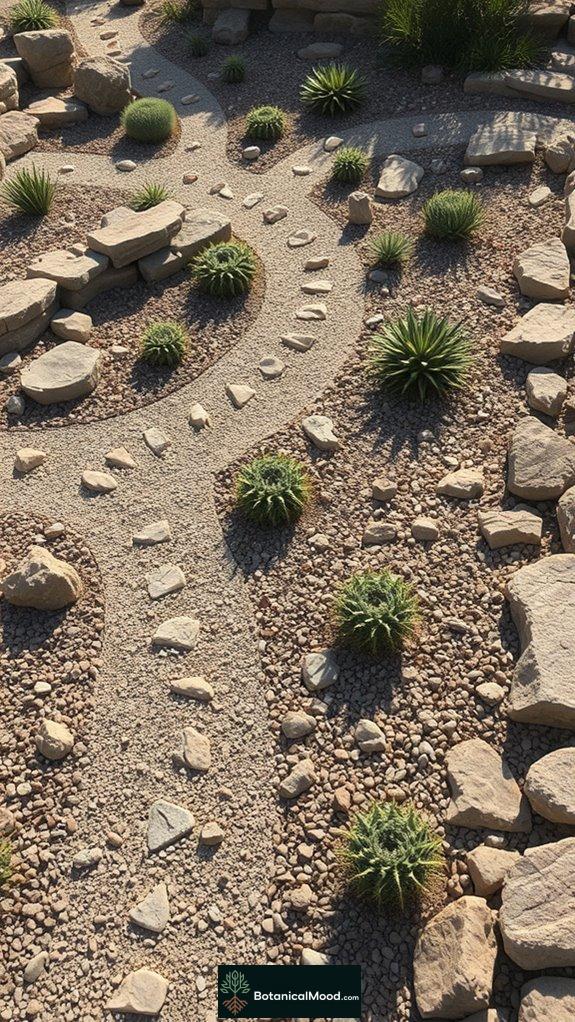
Creating a xeriscape rock garden not only enhances your outdoor space but also promotes water conservation in a stunning way.
By incorporating xeriscape materials like gravel and rocks, I can create a visually appealing terrain that reduces water usage. I select drought-resistant native plants, such as succulents and cacti, which thrive in native soil and require minimal watering.
Terracing and rock pathways help control erosion while maintaining moisture. This low-maintenance design not only lowers my utility bills but also showcases the beauty of innovative gardening. Additionally, using native plants is essential for establishing a resilient landscape that adapts well to local conditions.
At Botanical Mood, I aim to inspire others to embrace sustainable practices in their gardens.
Pollinator-Friendly Layout

While designing my xeriscape rock garden, I recognized the importance of fostering a vibrant ecosystem that supports pollinators. Creating pollinator pathways through native plants not only attracts bees and butterflies but also enhances habitat connectivity. I focused on diverse plant selections, ensuring continuous blooms from early spring to late fall, which provide essential food sources. By planting in large clumps, I reduced travel distances for these beneficial creatures. Incorporating structures like leaf litter offers overwintering habitats, while a simple dish of water serves as a hydration source. Additionally, using native plant selections in your garden can significantly improve the chances of attracting a variety of pollinators. My goal with Botanical Mood is to inspire others to embrace the beauty and functionality of pollinator-friendly gardens.
Mediterranean Planting Scheme
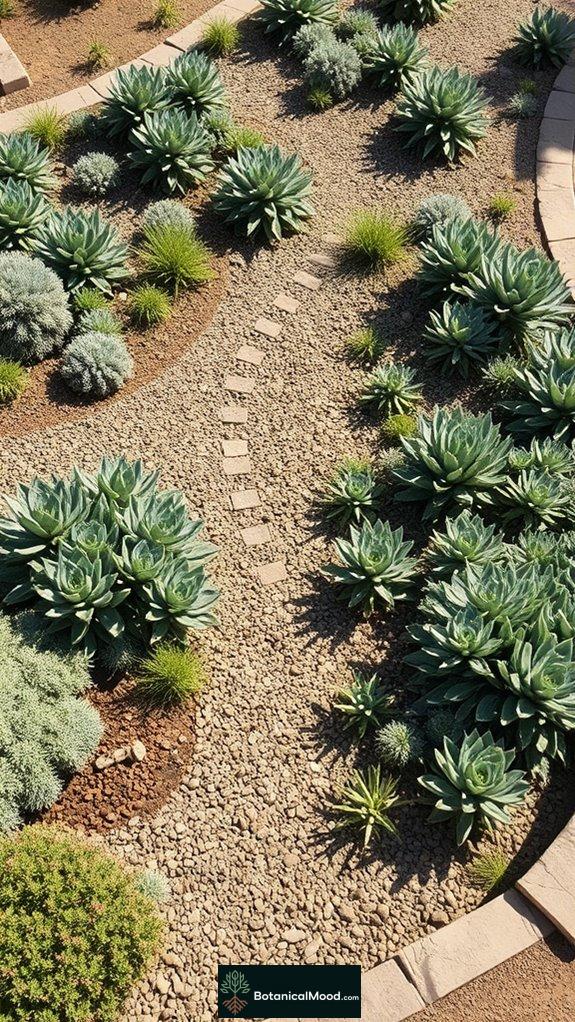
The Mediterranean planting scheme offers a stunning array of options for those looking to create a water-efficient garden that thrives in dry conditions.
By incorporating native plants, I embrace Mediterranean biodiversity, ensuring my garden flourishes with minimal water.
Embracing native plants allows my garden to thrive with minimal water, celebrating the rich biodiversity of the Mediterranean.
Using native soil amendments like compost enhances moisture retention, while efficient irrigation systems, such as drip lines, deliver water directly to roots.
I also love adding gravel pathways, allowing rainwater to seep into the soil.
This innovative approach not only conserves water but also celebrates the beauty of resilient plants, inspiring me to share my passion through Botanical Mood. Additionally, selecting drought-resistant species can significantly improve the sustainability of your garden.
Drought-Tolerant Perennial Beds

Drought-tolerant perennial beds not only enhance the beauty of a scenery but also promote sustainability by reducing water consumption.
By selecting innovative drought-resistant varieties, I've found that these perennial combinations create a vibrant setting that thrives with minimal care.
- Bearded Iris adds a splash of color.
- Yarrow's feathery foliage attracts pollinators.
- Russian Sage provides a lovely purple hue.
- Black-Eyed Susan requires little maintenance.
- Prairie Dropseed offers ornamental appeal.
These elements come together to form a resilient and visually stunning garden. Additionally, incorporating native plant species can further enhance water efficiency and biodiversity in your garden.
It's why I created Botanical Mood—to inspire others to embrace sustainable gardening practices.
Succulent and Cacti Arrangement
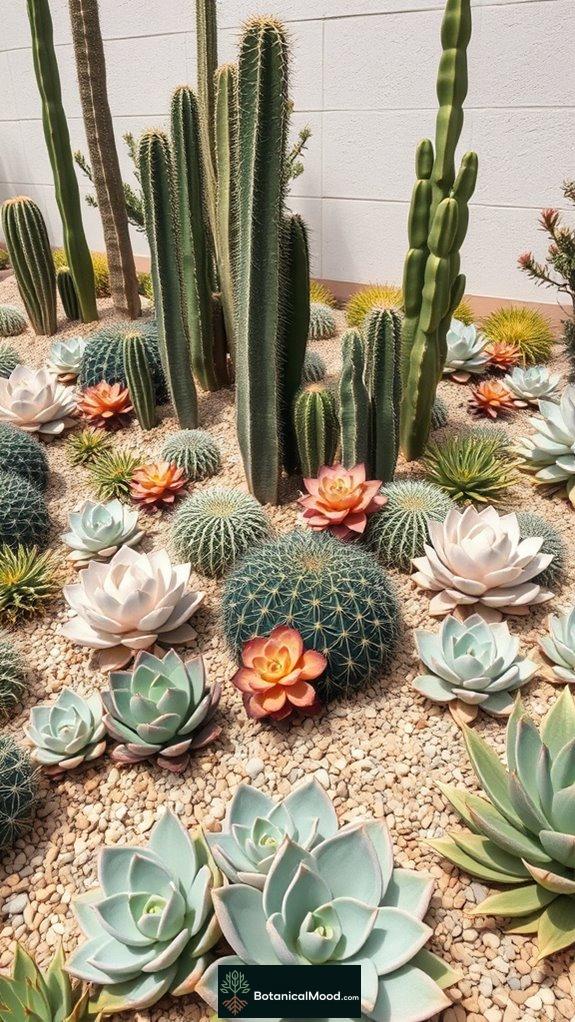
Creating a vibrant garden can be achieved with the enchanting beauty of succulent and cacti arrangements.
I love experimenting with different succulent varieties and cacti combinations to create striking visual interest.
By incorporating tall columnar cacti as focal points alongside low-growing succulents, I can achieve a dynamic environment that thrives on minimal water.
The unique textures of prickly pear cacti and colorful succulents offer endless design opportunities.
Using native plants not only enhances sustainability but guarantees a resilient garden that flourishes in local conditions.
Incorporating drought resistant plants into my design ensures not only beauty but also efficiency in water usage.
My passion for innovative gardening inspired the creation of Botanical Mood, where I share my journey and ideas.
Native Meadow Garden

While exploring the beauty of a native meadow garden, I can't help but appreciate how these vibrant spaces offer a harmonious blend of aesthetics and ecological benefits.
The rich native meadow aesthetics not only charm the eye but also support biodiversity benefits for local wildlife.
- Deep roots absorb water efficiently
- Pollutant filtering improves water quality
- Low-maintenance reduces upkeep costs
- Erosion prevention stabilizes soil
- Vibrant plant selection invites pollinators
Creating a native meadow garden aligns with my passion for sustainable design, showcasing nature's beauty while conserving resources. Additionally, incorporating regenerative planting techniques enhances soil health and promotes a thriving ecosystem.
It's a perfect way to bring innovation into our outdoor spaces.
Edible Native Plants Integration
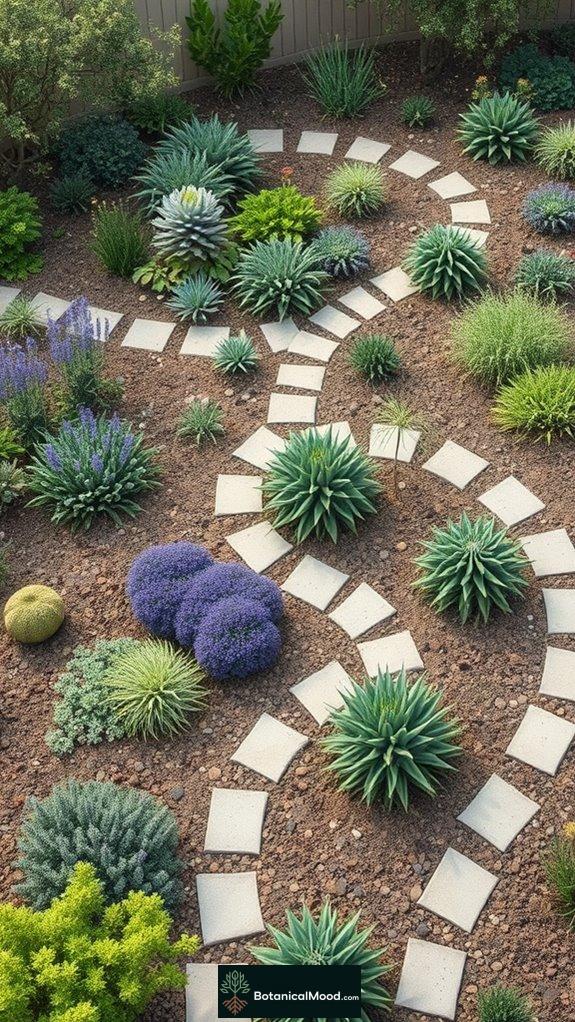
Integrating edible native plants into your garden not only enhances its beauty but also fosters a sustainable ecosystem that thrives on minimal resources.
By choosing plants like Blue Elderberry and Jerusalem Artichoke, I tap into native plant benefits, ensuring they require less water while promoting edible biodiversity.
Matching these plants to their preferred soil types optimizes water retention, and their inherent drought tolerance minimizes irrigation needs.
Plus, they naturally support pollinators, enriching the garden's productivity. Additionally, incorporating drought-resistant native plants can further improve the resilience of your garden against climate challenges.
My passion for sustainable gardening led me to create Botanical Mood, where I hope to inspire others to embrace these innovative, eco-friendly practices.
Vertical Native Plant Wall

When designing a vertical native plant wall, it's crucial to contemplate how the arrangement not only enhances aesthetic appeal but also contributes to environmental sustainability.
I've found that careful plant selection and vertical wall design can transform any space.
Here are some key considerations:
Key considerations include selecting native plants, using lightweight growing mediums, and ensuring structural integrity for sustainability.
- Choose native plants with shallow root systems.
- Use lightweight, effective growing mediums.
- Opt for water-efficient species to minimize irrigation.
- Guarantee structural integrity to support the design.
- Adapt to local climate conditions for plant survival.
Incorporating sustainable gardening practices into your design can further enhance the ecological benefits of your vertical garden wall.
At Botanical Mood, I aim to inspire innovative gardening solutions that harmonize beauty with ecological responsibility.
Dry Stream Bed Landscape
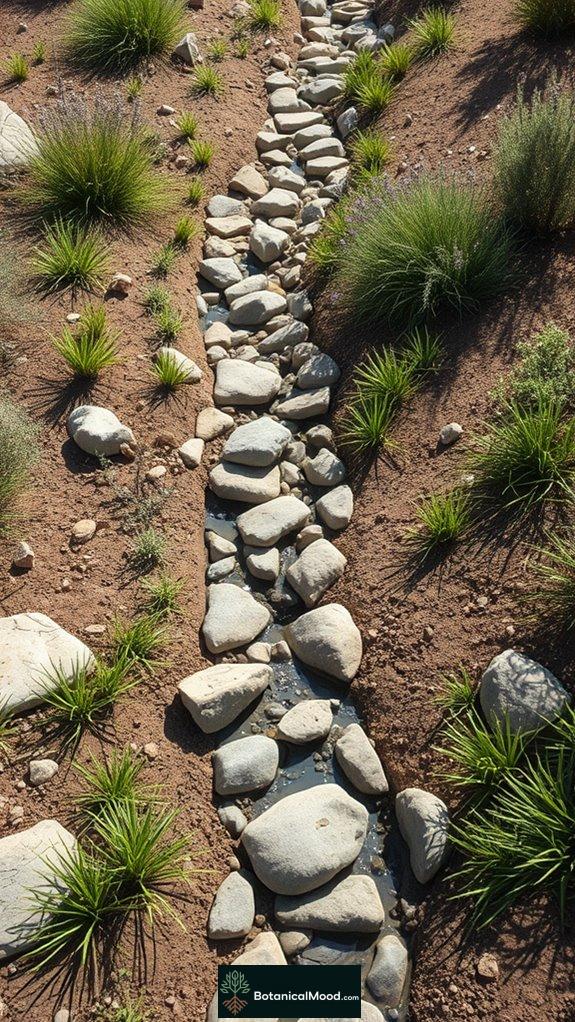
Creating a vibrant and functional garden space often leads us to explore various design elements, such as the vertical native plant wall I discussed earlier.
One innovative feature I love is the dry stream bed.
These beds not only manage water drainage effectively, preventing erosion, but they also add stunning aesthetic value to your surroundings.
By mimicking natural water flows with gentle curves and varying rock sizes, I can create an organic look.
Plus, integrating native plants guarantees water efficiency while enhancing the local ecosystem.
Embracing dry stream beds has been a game changer for my garden's beauty and sustainability. Additionally, utilizing natural drainage techniques can further optimize water management in your garden.
Drought-Tolerant Plant Arrangement

Drought-tolerant plant arrangement transforms how we approach gardening, especially in regions prone to dry spells.
By using innovative layout strategies, I can create stunning gardens that thrive with minimal water.
- Combine native plants for a natural look
- Group plants by water needs for efficiency
- Use deep-rooted species to access moisture
- Incorporate succulents for their resilience
- Layer with ornamental grasses for texture
These plant combinations not only enhance beauty but also support sustainability.
At Botanical Mood, I share these designs, inspiring others to embrace water-efficient gardening while celebrating nature's artistry.
Xeriscape Plant Grouping Strategy

Xeriscape plant grouping strategy emphasizes the importance of arranging plants based on their water needs, which not only enhances the aesthetic appeal of your garden but also maximizes water efficiency.
By clustering low-water plants together, I can minimize irrigation while still enjoying vibrant xeriscape aesthetics. Placing high-water plants near water sources creates stunning focal points, blending seamlessly with native plant benefits.
Transition zones allow for a harmonious mix of varying water needs, ensuring a visually enchanting experience.
As I explore innovative landscaping, I appreciate how thoughtful plant placement supports biodiversity and sustainability, ultimately fostering a thriving ecosystem in my garden.
Water-Conserving Plant Placement

Water conservation in garden design is more than just a trend; it's a necessity that reflects our commitment to sustainable practices.
When planning your native garden, consider the following for effective water-conserving plant placement:
- Choose native plants suited to your climate.
- Group plants with similar water needs through hydrozoning.
- Optimize plant spacing to prevent water pooling and encourage airflow.
- Match plants with their preferred soil types for better moisture retention.
- Incorporate a variety of drought-tolerant species to enhance biodiversity.
Garden Layout Maximizes Water Use

While planning a garden that maximizes water use, it's essential to think about the layout and how different elements come together to create an efficient, beautiful space.
Incorporating drip irrigation guarantees water reaches plant roots directly, reducing evaporation.
Utilizing drip irrigation ensures that water efficiently nourishes plant roots while minimizing evaporation losses.
I also focus on soil improvement through composting, which boosts water retention. Grouping plants by their water needs allows for efficient watering, while native plants thrive in local conditions, requiring less overall moisture.
These innovative strategies not only conserve water but also enhance the garden's beauty, inspiring my passion for sustainable design at Botanical Mood.
References
- https://extension.okstate.edu/fact-sheets/sustainable-landscapes-designing-a-rain-garden-for-residential-property.html
- https://www.saveourmonarchs.org/blog/may-17th-2018
- https://www.monrovia.com/be-inspired/rain-garden-design-and-plants.html
- https://www.aquabarrel.com/how-to-design-rain-garden
- https://www.dcva.org/Rain-Garden
- https://sensorex.com/xeriscape-gardens-principles/
- https://www.highcountrygardens.com/content/waterwise/how-to/plan-a-garden-xeriscape
- https://home.howstuffworks.com/lawn-garden/professional-landscaping/xeriscaping2.htm
- https://doanbrookpartnership.org/wp-content/uploads/2019/04/water-efficient_landscaping_508.pdf
- https://waterearthwindfire.com/water-conservation-in-the-garden/

Leave a Reply